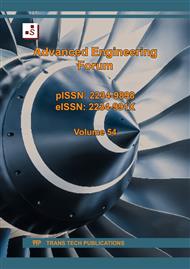[1]
Sharma, A., & Sharma, R. K. (2020). Strength and drainage characteristics of poor soils stabilized with construction demolition waste. Geotechnical and Geological engineering, 38(5), 4753-4760.
DOI: 10.1007/s10706-020-01324-3
Google Scholar
[2]
Abhishek, Sharma, R. K., & Bhardwaj, A. (2019). Effect of construction demolition and glass waste on stabilization of clayey soil. In Proceedings of the 1st International Conference on Sustainable Waste Management through Design: IC_SWMD 2018 1 (pp.87-94). Springer International Publishing.
DOI: 10.1007/978-3-030-02707-0_12
Google Scholar
[3]
Verma, A., & Sharma, R. K. (2023). Improving Characteristics of Clayey Soil Using Basalt Fibre, Construction and Demolition Waste and Calcium Carbide. International Journal of Sustainable Construction Engineering and Technology, 14(4), 447-465.
DOI: 10.30880/ijscet.2023.14.04.033
Google Scholar
[4]
Prajapati, A. R., Shah, A. U., Jain, P. H., & Rangwala, H. M. Improvement of Soil using Construction and Demolition Waste for Pavement Application.
Google Scholar
[5]
Islam, S., Islam, J., & Hoque, N. M. R. (2022). Improvement of consolidation properties of clay soil using fine-grained construction and demolition waste. Heliyon, 8(10).
DOI: 10.1016/j.heliyon.2022.e11029
Google Scholar
[6]
Zhang, G., Ding, Z., Zhang, R., Chen, C., Fu, G., Luo, X., ... & Zhang, C. (2022). Combined utilization of construction and demolition waste and propylene fiber in cement-stabilized soil. Buildings, 12(3), 350.
DOI: 10.3390/buildings12030350
Google Scholar
[7]
Sani, J. E., Etim, R. K., & Joseph, A. (2019). Compaction behaviour of lateritic soil–calcium chloride mixtures. Geotechnical and Geological Engineering, 37, 2343-2362.
DOI: 10.1007/s10706-018-00760-6
Google Scholar
[8]
Hussain Sadique, C. S. (2023). A systematic study to strengthen the sub grade of the pavement by stabilisation of expansive soil with molasses and jute fibre. Mathematical Statistician and Engineering Applications, 72(1), 668-682.
Google Scholar
[9]
Rabab'ah, S., Al Hattamleh, O., Aldeeky, H., & Alfoul, B. A. (2021). Effect of glass fiber on the properties of expansive soil and its utilization as subgrade reinforcement in pavement applications. Case Studies in Construction Materials, 14, e00485.
DOI: 10.1016/j.cscm.2020.e00485
Google Scholar
[10]
Patel, S. K., & Singh, B. (2019). Shear strength and deformation behaviour of glass fibre-reinforced cohesive soil with varying dry unit weight. Indian Geotechnical Journal, 49, 241-254.
DOI: 10.1007/s40098-018-0323-5
Google Scholar
[11]
Sharma, R. K., & Hymavathi, J. (2016). Effect of fly ash, construction demolition waste and lime on geotechnical characteristics of a clayey soil: a comparative study. Environmental Earth Sciences, 75, 1-11.
DOI: 10.1007/s12665-015-4796-6
Google Scholar
[12]
Shivakumar, C., Srikanth, B., Kumar, K. S., & Keerthi, N. (2020, November). Study on Improvement of Black Cotton Soil by Using Fines of Concrete Cube & Brick Demolition Waste. In IOP Conference Series: Materials Science and Engineering (Vol. 955, No. 1, p.012060). IOP Publishing.
DOI: 10.1088/1757-899x/955/1/012060
Google Scholar
[13]
Latifi, N., Vahedifard, F., Ghazanfari, E., & Rashid, A. S. A. (2018). Sustainable usage of calcium carbide residue for stabilization of clays. J. Mater. Civ. Eng, 30(6), 04018099
DOI: 10.1061/(asce)mt.1943-5533.0002313
Google Scholar
[14]
Jiang, N. J., Du, Y. J., Liu, S. Y., Wei, M. L., Horpibulsuk, S., & Arulrajah, A. (2015). Multi-scale laboratory evaluation of the physical, mechanical and microstructural properties of soft highway subgrade soil stabilized with calcium carbide residue. Canadian Geotechnical Journal, 53(3), 373-383.
DOI: 10.1139/cgj-2015-0245
Google Scholar
[15]
Julphunthong, P., Joyklad, P., Manprom, P., Chompoorat, T., Palou, M. T., & Suriwong, T. (2024). Evaluation of calcium carbide residue and fly ash as sustainable binders for environmentally friendly loess soil stabilization. Scientific Reports, 14(1), 671.
DOI: 10.1038/s41598-024-51326-x
Google Scholar
[16]
Baskar, I., Keerthana, K., Sakthisri, K., & Sona, R. (2022). Effect of calcium carbide residue and flyash in soil stabilisation for sand mixed clayey soil. Materials Today: Proceedings, 69, 1253-1259.
DOI: 10.1016/j.matpr.2022.08.323
Google Scholar
[17]
Avinash, B., & Kumar, S. R. (2023). Influence of industrial wastes and lime on strength characteristics of clayey soil. Magazine of Civil Engineering, 120(4), 12002.
Google Scholar
[18]
M'Ndegwa, J. K. (2011). The effect of cane molasses on strength of expansive clay soil. Journal of Emerging Trends in Engineering and Applied Sciences, 2(6), 1034-1041.
Google Scholar
[19]
Taye, B., & Araya, A. A. (2015, May). Stabilization of expansive clay soil with sugar cane molasess and cement. In Proceedings of the 2nd International Conference on Transportation in Africa (ICTA2015) Majestic Five Hotel, Palapye, Botswana (pp.25-27).
Google Scholar
[20]
WENDIWESEN, Y. (2017). STABILIZING EXPANSIVE SOIL BY USING SUGAR CANE MOLASSES AND CERAMIC DUST (Doctoral dissertation).
Google Scholar
[21]
Farshadi, A., Mehrnahad, H., & Abdoli, M. (2023). Effects of glass fibers and nanoclay on the strength parameters of aeolian sand: An experimental study. Bulletin of Engineering Geology and the Environment, 82(7), 278.
DOI: 10.1007/s10064-023-03317-x
Google Scholar
[22]
Abbeche, K., Panczer, G., & Belagraa, L. (2020). Study of the effect of waste glass fibers incorporation on the collapsible soil stability behavior. KnE Engineering, 157-166.
DOI: 10.18502/keg.v5i4.6806
Google Scholar
[23]
Bakir, N., Abbeche, K., & Panczer, G. (2017). Experimental study of the effect of the glass fibers on reducing collapse of a collapsible soil. Geomechanics and Engineering, 12(1), 71-83.
DOI: 10.12989/gae.2017.12.1.071
Google Scholar
[24]
Bhadoriya, A., & Kansal, D. R. (2018). Black Cotton Soil Stabilization using Plastic and Glass Fibres. International Research Journal of Engineering and Technology (IRJET), 5(11), 856-861.
Google Scholar
[25]
Parihar, N. S., Garlapati, V. K., & Ganguly, R. (2018). Stabilization of black cotton soil using waste glass. Handbook of environmental materials management, 1-16.
DOI: 10.1007/978-3-319-58538-3_147-1
Google Scholar


